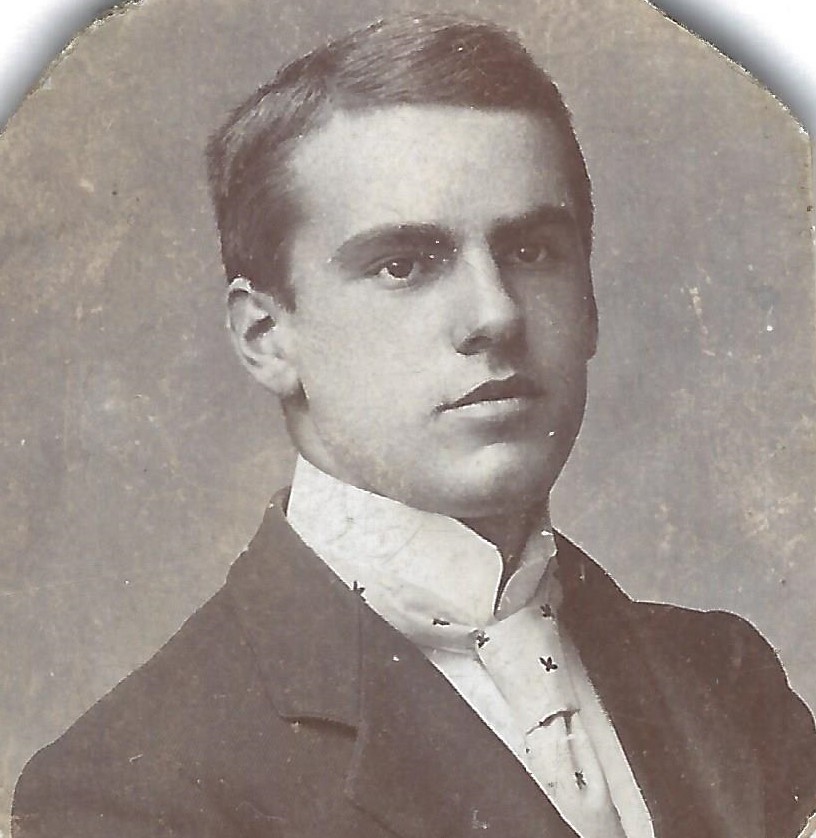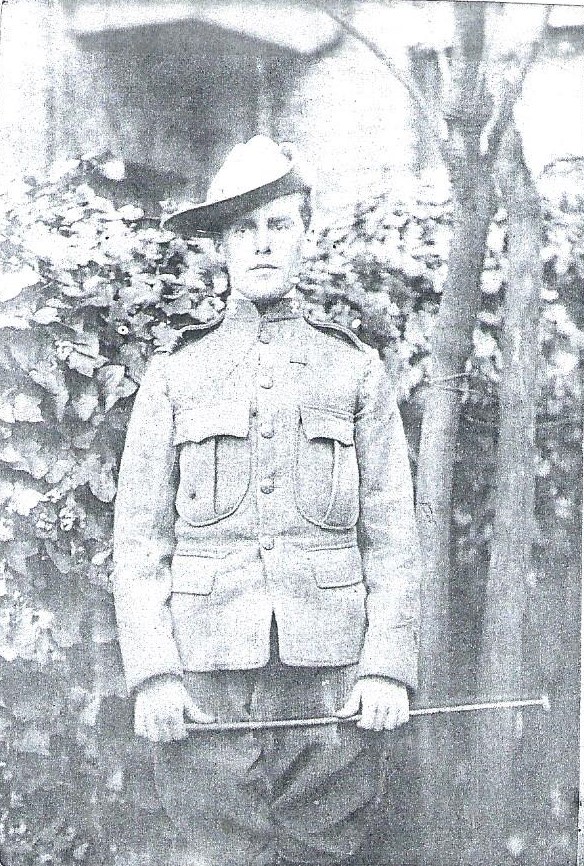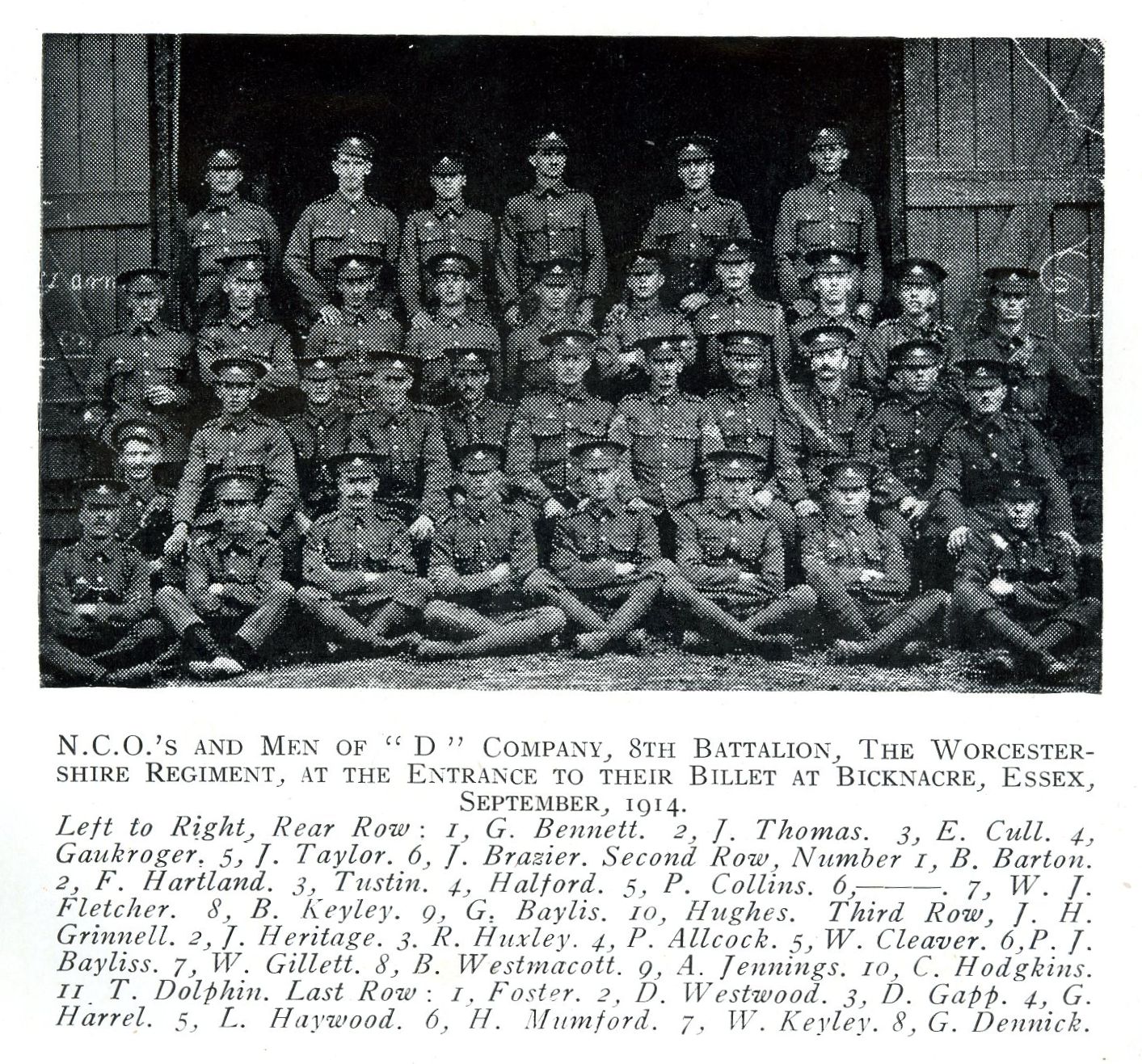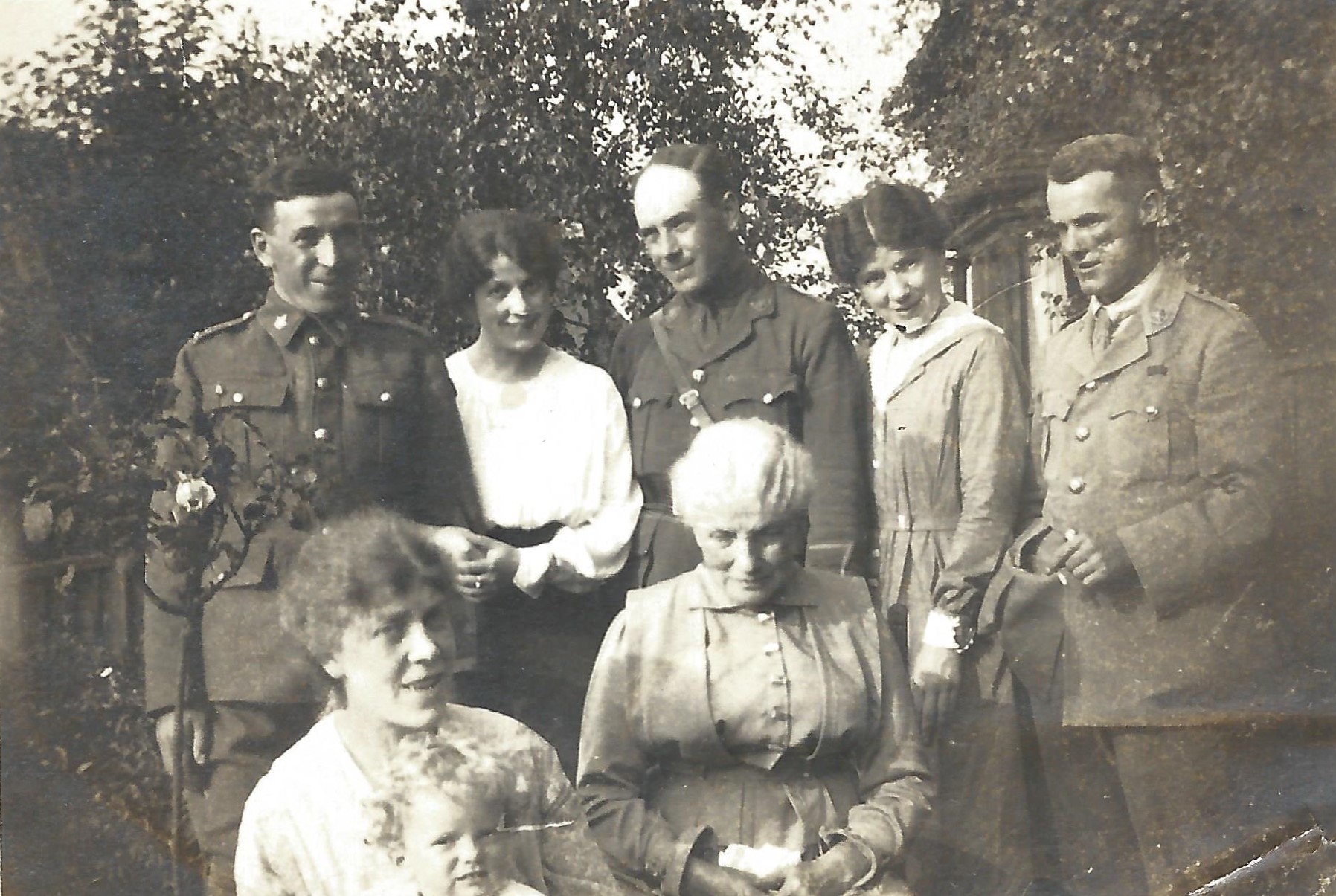 Bernard Barton moved to Badsey in 1913 when he took on the tenancy of Bowers Hill Farm. Lieutenant-Colonel Barton’s name is recorded on the war memorial in St James’ Church, Badsey. He is also remembered on memorials at St Peter’s School, York; St Andrew’s Church, Grimsby, Ontario, Canada; Bushey, Hertfordshire.
Bernard Barton moved to Badsey in 1913 when he took on the tenancy of Bowers Hill Farm. Lieutenant-Colonel Barton’s name is recorded on the war memorial in St James’ Church, Badsey. He is also remembered on memorials at St Peter’s School, York; St Andrew’s Church, Grimsby, Ontario, Canada; Bushey, Hertfordshire.
* * * * *
Bernard Barton was born at Fridaythorpe Vicarage, Malton, Yorkshire, in 1879, the third child of the Reverend Thomas Haycraft Barton by his second wife, Jane. As well as two older brothers, Frederick Howard (1876-1946) and Harold (1877), and a younger sister, Dorothea (1883-1958), Bernard’s family comprised of half-siblings who were all considerably older than him: Elizabeth Lanfear (1852-1923), Catherine Mary (1853-1916), Florence Isabella (1855-1876), Eugenia (1857-1939) and Charles Albert (1861), all born at East Acklam, Yorkshire, where Thomas was then Curate.
Bernard’s mother, Jane Longden Davy, was some 27 years younger than Thomas Haycraft Barton when she married him in 1874. She was aged only 23 when she took charge of the household at Fridaythorpe Vicarage and became step-mother to Thomas’ children, some of whom were only a few years younger than herself.
Bernard spent his childhood in Fridaythorpe, a village in the East Riding of Yorkshire. At 170 m above sea level, it is the highest village in the Yorkshire Wolds, and has extensive views towards Flamborough Lighthouse and the sea. Today, the Yorkshire Wolds Way National Trail, a long-distance footpath, passes through the village, which is the midpoint of the trail. St Mary’s Church, where his father was Vicar, has been designated by English Heritage as a Grade I listed building.
At the time of the 1881 census, 1½-year-old Bernard lived at the Vicarage with his two older brothers and two of his half-sisters, Elizabeth and Eugenia, plus two servants. By 1891, the half-sisters had left home, but there was now a younger sister, Dorothea, to complete the family.
Bernard’s father, Thomas Barton, died in 1894 at Fridaythorpe when Bernard was aged 14. Bernard was by then a pupil at St Peter’s School, York, reputed to be the oldest school in England. By the time that Jane proved her husband’s will two months later, she was living at 11 Avenue Terrace, Clifton, York. Widowed Jane was still living at the same address in York in 1901 with one of her sons, Frederick, who was a clerk at the waterworks, and her youngest child, Dorothea. By this time, Bernard was overseas, serving in the South African War. The photos below show Bernard (pictured centre) en route to South Africa and at Heilbron during the South African War.
.jpg)
.jpg)
 According to his obituary in the Parish Magazine of September 1918, Bernard was formerly on the organising staff of the “Yorkshire Herald”. This was probably just before or just after his service in South Africa.
According to his obituary in the Parish Magazine of September 1918, Bernard was formerly on the organising staff of the “Yorkshire Herald”. This was probably just before or just after his service in South Africa.
In 1904, Bernard set sail for a new life in Canada. He settled in Grimsby, Lincoln district, a town on Lake Ontario in the Niagara region, where he established his own small fruit farm, in partnership with another English settler, Sydney Boyes, who had left England in 1896.
Two years later, Bernard’s younger sister, Dorothea Garrett, followed in Bernard’s footsteps when she and her husband, Guy, emigrated to Canada with their baby daughter, Ruby Elizabeth, and started a peach farm in North Grimsby. Two more daughters were born in Canada: Margaret Joyce in 1909 and Ruth Aileen in 1911, both of whom were baptised at St Andrew’s Church, Grimsby. In 1908, Bernard and Dorothea’s widowed mother, Jane Longden Barton, also emigrated to Canada and went to live with the Garretts, so Bernard had several family members close by.
It seems that farming in Canada did not work out for Bernard, as he was back in England by April 1913, when he married in Bushey, Hertfordshire. Dorothea and Guy Garrett had returned to the UK in August 1911 because hail had destroyed the crop and they had no money left for assets, so this may well have been the same reason why Bernard left.
Bernard’s bride was Elena Elizabeth Atkins, known as Nell, the daughter of a Hertfordshire farmer. It was probably shortly after the marriage that they moved to Badsey when Bernard became a tenant at Bowers Hill Farm, a farm of some 90 acres on the outskirts of the village.
On the outbreak of war, Bernard enlisted with the local company of Territorials in August 1914 and later that year was commissioned in the Worcestershire Regiment. He joined the newly formed 11th (Service) Battalion which came under orders of 78th Brigade in 26th Division. Battalion Headquarters were established at Barbourne College (now Gheluvelt Park, Worcester). In early April 1915, Bernard moved with his company to Norton Barracks, then at the end of the month moved to camp at Fovant in Wiltshire. In July 1915 the Battalion moved again to Longbridge Deverill. The London Gazette of 13th August 1915 reveals that he had by now been promoted to temporary Captain. He was a Captain in D Company.

Bernard first went overseas on active service in September 1915. The 11th Worcestershire, with other Battalions of the 78th Brigade, left its Wiltshire training ground at Longbridge Deverill on the 21st September 1915, entrained at Warminster for Southampton, and thence crossed to Boulogne. Their stay in France was short-lived as, in November, they were redeployed to Salonika (today called Thessalonika), at the request of the Greek Prime Minister. The objective was to help the Serbs in their fight against Bulgarian aggression. But the expedition arrived too late, the Serbs having been beaten before they landed. It was decided to keep the force in place for future operations, thus much of the first part of 1916 was spent in training.
Meanwhile, back at Bowers Hill, Badsey, Nell gave birth to a son, Bernard Philip George Barton (known as Philip), born in December 1915 and baptised at Wickhamford in January 1916. Whilst Bernard was leading a rather monotonous existence in the Macedonian hills, matters relating to his short-lived business venture at Bowers Hill were coming to a head. Application was made in June 1916 to the court at Evesham for possession of Bowers Hill Farm, stating that the tenant, Barton, had deserted it leaving it uncultivated and unoccupied and with £290 arrears of rent. The justices of the peace, James Ashwin of Bretforton and Charles Binyon of Badsey, after visiting the farm, granted possession. Nell and her young son returned to live in her home town of Bushey.
On 20th May 1916, the regimental diary tells us that Captain Barton with 50 other ranks, was sent to guard an aerodrome on the island of Thassos. They rejoined the battalion on 10th August, in time for the attack on Horseshoe Hill. At the beginning of October 1916, the British, in co-operation with her allies on other parts of the front, began operations on the River Struma towards Serres. The campaign was successful with the capture of the Rupell Pass and advances to within a few miles of Serres.
During 1917 there was comparatively little activity on the British part of the front in Macedonia, due in part to complex political changes in Greece throughout the year. The main fighting took place around Lake Doiran, where the line was adjusted several times by each side early in the year. According to the Parish Magazine of August 1917, Captain Barton was mentioned in the dispatch from Salonika published on 23rd July. In his obituary published the following year, it notes that “he was severely wounded on the Salonika front in March 1917 and returned to England in consequence. On the voyage home the ship was attacked by enemy submarines in the Mediterranean, but succeeded in reaching port. He remained in England until April of the present year when he was sent to France.”

On returning to active service from convalescence, Bernard was then attached to the 2nd/8th Battalion and went with them to France in April 1918. In June 1918, he was appointed to the rank of Lieutenant-Colonel. Bernard was killed in action on 11th August 1918, aged 39. He was buried at Tannay British Cemetery, Thiennes, Nord, France. The Parish Magazine of September 1918 reveals that Private Thomas Hartwell Knight, who used to work on land close to Colonel Barton’s, attended the funeral in the capacity of bandsman. Private Knight was himself to die three months later, five days before the end of the war. The obituary commented that he was one of the first from Badsey to volunteer for service and that his advancement was remarkably rapid. A memorial service was held at Wickhamford on 4th September.
Bernard was also remembered in Canada. “The Grimsby Independent” of 11th September 1918 reported as follows:
Barton, Lieut.-Col. Bernard, of an Imperial Unit is reported as having been killed in action on August 1st by the bursting of a bomb. Lieut.-Col. Barton will be remembered in this district by a great number of people, as for some years he worked a small fruit farm on Maple Avenue, along with his partner, Sydney Boyes, under the name of Barton & Boyes. He left this district some time previous to the outbreak of war and immediately after the declaration of war, gave his services.
Bernard’s former business partner, Sydney Boyes, was also killed in France, two months before Bernard. Sydney was buried in Harponville Communal Cemetery Extension and his names appears immediately beneath Bernard’s on the war memorial in St Andrew’s Churchyard, Grimsby.
During Bernard’s period of convalescence in England, a second son was conceived, Stephen Bernard, who was born posthumously two and a half months after his father’s death. Nell was living at 21 Nightingale Road in her home town of Bushey at the time. Administration of Bernard’s will was granted to Nell with effects of £495 3s 1d.
Bernard’s widow, Nell, never remarried. She later moved to Green Point Cottage, Avenue Rise, Bushey. She died in the Barnet district in 1967. His elder son, Philip, married in London in 1937 and had a son, Philip. Philip later emigrated to Canada where he died at Oakville, Ontario in 1999. Bernard’s younger son, Stephen, moved to America later in life and died there in 1994 leaving a young family by a second wife.
Bernard’s sister, Dorothea, also lived in Bushey, at Park Road, which was just a short distance from her widowed sister-in-law. Dorothea’s husband, Guy, had gone out to Angola and died of blackwater fever in 1923. Dorothea died at Bushey in 1958.
* * * * *
We are grateful to Bernard Barton’s great-nephew, Philip Plumbe of Melbourne, Australia, for supplying information and for granting permission for copies of photographs to be used.
